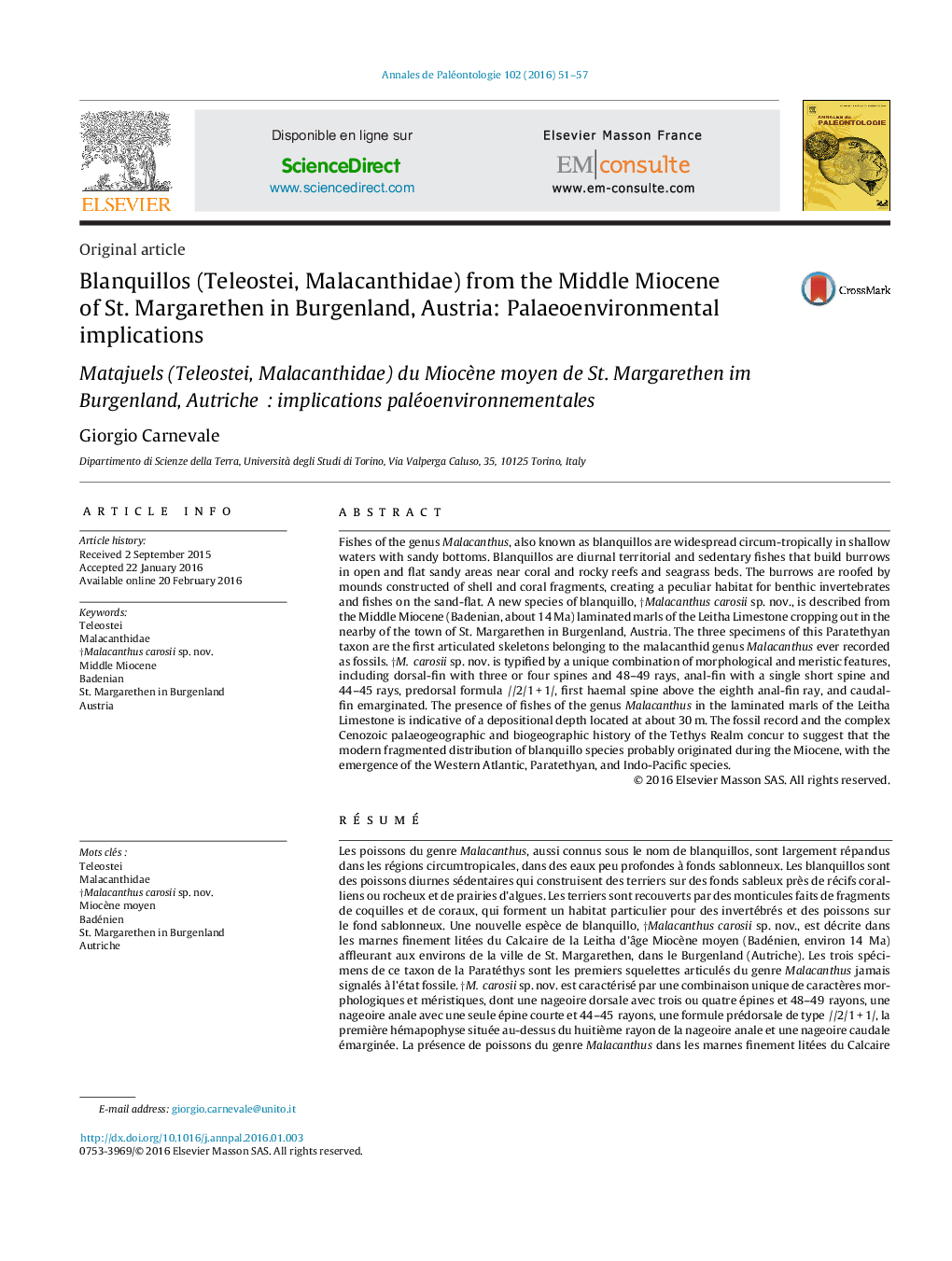| کد مقاله | کد نشریه | سال انتشار | مقاله انگلیسی | نسخه تمام متن |
|---|---|---|---|---|
| 4745256 | 1359695 | 2016 | 7 صفحه PDF | دانلود رایگان |
Fishes of the genus Malacanthus, also known as blanquillos are widespread circum-tropically in shallow waters with sandy bottoms. Blanquillos are diurnal territorial and sedentary fishes that build burrows in open and flat sandy areas near coral and rocky reefs and seagrass beds. The burrows are roofed by mounds constructed of shell and coral fragments, creating a peculiar habitat for benthic invertebrates and fishes on the sand-flat. A new species of blanquillo, †Malacanthus carosii sp. nov., is described from the Middle Miocene (Badenian, about 14 Ma) laminated marls of the Leitha Limestone cropping out in the nearby of the town of St. Margarethen in Burgenland, Austria. The three specimens of this Paratethyan taxon are the first articulated skeletons belonging to the malacanthid genus Malacanthus ever recorded as fossils. †M. carosii sp. nov. is typified by a unique combination of morphological and meristic features, including dorsal-fin with three or four spines and 48–49 rays, anal-fin with a single short spine and 44–45 rays, predorsal formula //2/1 + 1/, first haemal spine above the eighth anal-fin ray, and caudal-fin emarginated. The presence of fishes of the genus Malacanthus in the laminated marls of the Leitha Limestone is indicative of a depositional depth located at about 30 m. The fossil record and the complex Cenozoic palaeogeographic and biogeographic history of the Tethys Realm concur to suggest that the modern fragmented distribution of blanquillo species probably originated during the Miocene, with the emergence of the Western Atlantic, Paratethyan, and Indo-Pacific species.
RésuméLes poissons du genre Malacanthus, aussi connus sous le nom de blanquillos, sont largement répandus dans les régions circumtropicales, dans des eaux peu profondes à fonds sablonneux. Les blanquillos sont des poissons diurnes sédentaires qui construisent des terriers sur des fonds sableux près de récifs coralliens ou rocheux et de prairies d’algues. Les terriers sont recouverts par des monticules faits de fragments de coquilles et de coraux, qui forment un habitat particulier pour des invertébrés et des poissons sur le fond sablonneux. Une nouvelle espèce de blanquillo, †Malacanthus carosii sp. nov., est décrite dans les marnes finement litées du Calcaire de la Leitha d’âge Miocène moyen (Badénien, environ 14 Ma) affleurant aux environs de la ville de St. Margarethen, dans le Burgenland (Autriche). Les trois spécimens de ce taxon de la Paratéthys sont les premiers squelettes articulés du genre Malacanthus jamais signalés à l’état fossile. †M. carosii sp. nov. est caractérisé par une combinaison unique de caractères morphologiques et méristiques, dont une nageoire dorsale avec trois ou quatre épines et 48–49 rayons, une nageoire anale avec une seule épine courte et 44–45 rayons, une formule prédorsale de type //2/1 + 1/, la première hémapophyse située au-dessus du huitième rayon de la nageoire anale et une nageoire caudale émarginée. La présence de poissons du genre Malacanthus dans les marnes finement litées du Calcaire de la Leitha suggère une profondeur de dépôt d’environ 30 m. Le témoignage des fossiles et l’histoire paléogéographique et biogéographique complexe du domaine téthysien au Cénozoïque conduit à suggérer que la distribution actuelle fragmentée des blanquillos remonte probablement au Miocène avec l’apparition des espèces de l’Atlantique occidental, de la Paratéthys et de l’Indo-Pacifique.
Journal: Annales de Paléontologie - Volume 102, Issue 1, January–March 2016, Pages 51–57
